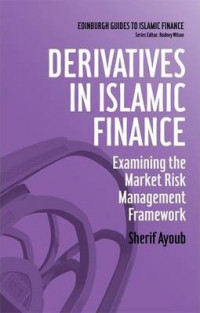


Text
Derivatives in Islamic finance : examining the market risk management framework
Includes bibliographical references (p. 229-250) and index.; 1. Introduction -- 2. Truth formation in Mua'amalat -- 2.0. Introduction -- 2.1. The path to the truth: the role of Maslaha, Qiyas and Igma'a -- 2.2. Truth-seeking in the scripture: the reality imposed by critical rationalism and hermeneutics -- 2.3. Conclusion -- 3. Market risks and their management -- 3.0. Introduction -- 3.1. Risk and its management -- 3.2. Risk identification -- 3.3. Risk measurement -- 3.4. Risk strategy -- 3.5. Rationale for hedging -- 3.6. Conclusion -- 4. Conventional derivatives: theory and practice -- 4.0. Introduction -- 4.1. Economics of derivatives -- 4.2. Conventional derivative instruments -- 4.3. Conclusion -- 5. Derivatives in Islamic finance -- 5.0. Introduction -- 5.1. Resolutions by standard-setting bodies in Islamic jurisprudence -- 5.2. Theoretical Shari'ah issues -- 5.3. Contractual Shari'ah issues -- 5.4. Contemporary derivatives in Islamic finance -- 5.5. Conclusion -- 6. Permissibility of the underlying variables and the recognition of the contract -- 6.0. Introduction -- 6.1. Permissibility of the underlying variables: interest rate benchmarks -- 6.2. Permissibility of the underlying variables: currency benchmarks -- 6.3. The nature of money in Islam -- 6.4. Recognition of the derivative contract -- 6.5. Conclusion -- 7. Maysir, hedging and derivatives -- 7.0. Introduction -- 7.1. A conceptualisation of Maysir in Islamic and Western thought -- 7.2. Maysir, Gharar and the indeterminacy of the zero-sum prohibition -- 7.3. Investment, speculation and gambling: the environment of risk management -- 7.4. The role of financial intermediaries as speculators -- 7.5. Conclusion -- 8. Conclusion.;
Ketersediaan
| PR180016 | Perpustakaan Pusat UIN Walisongo | Tersedia namun tidak untuk dipinjamkan - No Loan |
Informasi Detail
- Judul Seri
-
-
- No. Panggil
-
2X6.32 AYO d
- Penerbit
- Edinburgh : Edinburgh University Press,., 2014
- Deskripsi Fisik
-
x, 260 p. ; 22 cm.
- Bahasa
-
English
- ISBN/ISSN
-
9780748695706
- Klasifikasi
-
2X6.32
- Tipe Isi
-
text
- Tipe Media
-
-
- Tipe Pembawa
-
volume
- Edisi
-
-
- Subjek
- Info Detail Spesifik
-
-
- Pernyataan Tanggungjawab
-
Sherif Ayoub.
Versi lain/terkait
Tidak tersedia versi lain
Lampiran Berkas
Komentar
Anda harus masuk sebelum memberikan komentar